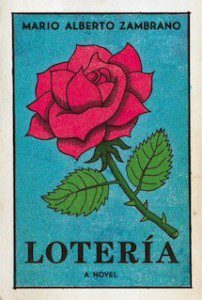
Considered a variant of bingo, the Latin American card game lotería is more than a game of chance. Played with a deck of 54 vibrant cards, lotería also is a game of association, requiring the dealer to recite a unique riddle corresponding to each card. In his debut novel Lotería, Mario Alberto Zambrano subverts the rules of the game, and in doing so, he writes a playbook for a new game whose consequences are more dire than they initially seem. Written in 53 vignettes, each preceded by a color reproduction of a lotería card, Zambrano’s novel is itself an act of free association, allowing two conflicting stories to emerge as the narrative approaches its cataclysmic reveal.
Lotería consists of the journal entries of eleven year-old Luz María Castillo, a Mexican-American tomboy whose gritty and guarded voice masks a deep anger and vulnerability. When her father is imprisoned, Luz is placed under care of the state and taken to a facility where she is expected to provide evidence of her father’s innocence. With her sister in the ICU and her mother recently disappeared after years in a tumultuous relationship with Luz’s father, Luz refuses to speak to her caregivers. Instead, she keeps a journal, using her deck of lotería cards to guide her story. Zambrano organizes the novel’s micro-chapters around Luz’s association with each particular card, effectively rewriting the predetermined riddles linked to the cards, and creating a complex new game unique to Luz’s traumatic past. This structure allows Zambrano to slide backwards and forwards in time, as Luz gradually comes to terms with the series of violent ruptures that have permanently altered her family and forced her to choose between remaining in the United States at a home for displaced youths, or moving to Mexico with her aunt.
While she refuses to speak, Luz’s voice as a storyteller is marked by her anger at her family and circumstances, coupled with a guarded nostalgia for a childhood marred by violence and abuse. Because Luz selects her cards at random and then mediates on a memory or anecdote that the card elicits, the novel’s action moves circularly, with Luz revealing tangents that gradually acquire meaning. Zambrano has meticulously organized Luz’s anecdotes and associations in order to tell two stories: the implied story of Luz’s present reality as she writes alone in her room, reeling from an apocalyptic loss, and the spinning mobile of stories and memories that the cards reveal.

As she turns over the first cards, Luz is adjusting to her solitude and is nostalgic for her loving parents and their community of other Mexican immigrants whom she views as her extended family. Luz reminisces about long afternoon games of lotería with friends, and sketches a family portrait filled with love and music. She describes her father as a boisterous, proud, and fun-loving man, who would sing rancheros after a day’s work: “Mom would open the back door wearing nothing but an oversized T-shirt and tell us to be quiet before she even asked what we were doing. Papi would hit his chest with both fists, like Tarzan […] I’d laugh, and she would too. We’d laugh so hard it’d take me awhile before I could sing. Then finally we’d sing. The same along, always, all together, all three of us.”
External pressures slowly pervade Luz’s journal, as readers learn that her older sister Estrella is in critical condition, and her father’s trial is at a standstill without her testimony. As the novel progresses, we see the influences of these pressures on Luz’s readings of the cards. Zambrano gradually reveals the violence that characterized Luz’s home life, as Luz begins to describe her parents’ arguments and the physical abuse she and her sister suffered at their father’s hand. Luz’s self-conscious toughness begins to falter when she leaves the facility to visit her sister in the hospital: “Standing there, all of a sudden, I was like a jug of water trying to be taken from one place to another, and little by little, I was spilling.” Soon, her memories begin to take focus, leading to the violent climax that sheds light on Luz’s anger and trauma. It is here, as Luz’s recollections begin to directly interact with her daily reality, that Zambrano shows his masterful hand. Zambrano slowly reveals the second story hovering above Luz’s memories and anecdotes. Without compromising the authenticity of Luz’s voice, Zambrano reveals his character to be deeply vulnerable. By the novel’s close, Luz’s two conflicting realities reach an inevitable confrontation that blows apart what she thinks of her family and herself.
Some reader reviews of Lotería suggest an alienation felt by those unfamiliar with the Spanish words and phrases that Zambrano employs throughout the novel. Zambrano’s choice to not translate from the Spanish represents a broader decision in his portrayal of Luz’s daily life. While surrounded by a community of Mexican-Americans, Luz feels uncomfortable attending Spanish mass, and frequently makes mistakes when speaking Spanish to her family and friends. When she briefly visits Mexico, Luz turns to her aunt to translate a storekeeper’s words. Mexican culture and slang are vital to the fabric of Luz’s childhood and family, and Zambrano’s dialogue and cultural references reflect this marriage of American and Mexican cultures. Luz’s complicated relationship to her heritage–she resents that her lighter-skinned sister claims to be Spanish rather than Mexican–is a subtle but important thread that Zambrano weaves through the narrative and reinforces in his choices to accurately represent the dialogue of a Spanglish-speaking family. In refusing to sanitize Luz’s experience, Zambrano may be forcing his readers to empathize with Luz’s own sense of alienation and confusion as she straddles two cultural lines. In Lotería, Zambrano creates a structure which allows for a multifaceted examination of Luz’s life and memories, and in doing so he calls to life a complex character who determines the rules of her own game.




